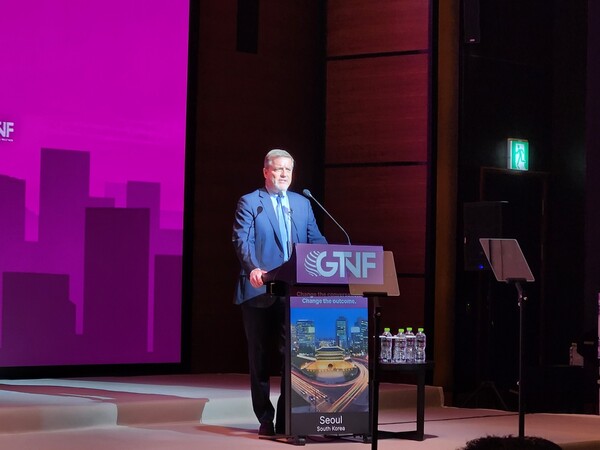Regulators from across the globe emphasized that the realization of the “Smokefree 2030” policy requires the introduction of rational e-cigarette regulation policies through collaboration between the tobacco industry, regulators, and policymakers.

The 13th Global Tobacco & Nicotine Forum 2023 (GTNF 2023), kicked off day two of the conference on Wednesday at the Conrad Hotel, Yeouido, Seoul. The event invites government officials, health experts, industry representatives, and media from countries that are at the forefront of the tobacco issues.
However, this is the first time the conference is being held in Asia, starting with Korea.
Under the theme "Change the Conversation, Change the Outcome," the opening keynote was delivered by Jonathan Atwood on behalf of Kingsley Wheaton, BAT Chief Strategy & Growth Officer, on the topic of smarter regulation to build a smoke-free 2030.
The discussion delved into five policy directions for tobacco harm reduction (THR) including the use of advanced technologies in devices that can limit underage access to vaping products, flavor and fragrance choices that are not preferred by minors, blocking the entry of unregulated and illegal products into the market, reviewing retail locations and sales qualification restrictions, and strengthening enforcement and penalties.
"Increased education and understanding of THR will enable consumers to switch to products that are less harmful than they were at the start of the year, and vaping has an important role to play in realizing governments' tobacco control strategies globally," said Wheaton.
He pointed to the need for a balanced solution to THR, underage use, and environmental concerns, adding that strict penalties are needed for irresponsible companies that fail to comply with regulations.
"Enabling smokers to choose tobacco-free alternatives freely will play a critical role in reducing smoking," he said. "Industry, policymakers, and public health experts must do more to educate the public about the scientific evidence supporting tobacco harm reduction."
Meanwhile, Ming Deng, Head of the NGPs industry study at Yunnan University, shared the Asian regulatory landscape.

Using China, Japan, Indonesia, and India as examples of Asian countries with the largest economies in the tobacco industry, he demonstrated that each country has different regulatory approaches which have not necessarily led to positive outcomes. For example, he questioned the effectiveness of India’s tobacco control policy which banned e-cigarettes in 2019 as well as heated tobacco products (HTPs). Consequently, this resulted in the flourishing of the illicit tobacco market.
However, he pointed to Indonesia as a potential hub for next-generation products (NGPs) such as HTPs which have gained significant traction in the country as its national standards which permit both HTP and e-cigarettes are not mandatory but rather endorsements by the government.
He also criticized the WHO Framework Convention on Tobacco Control (FCTC) for being vague in addressing the harm reduction properties of NGPs which he says can potentially create regulatory loopholes among member countries.
Lastly, he highlighted two compelling cases of NGPs such as KT&G’s lil AIBLE which is a Korean product that integrates AIoT application in its heated tobacco unit while combining features of vape together with HTPs.
“This convergence of vape and HTPs may represent a future trend,” Deng said.
He also explained that the natural smoke cigarettes (NSC) in China which feature the three elements of combustion, namely temperature, combustibles, and ignition boosters to provide an oxygen-free environment may offer a superior smoking experience, a fundamental principle in the next-generation product innovation with a focus on understanding the customer needs.
"There is a lack of cooperation among the multinational companies (MNCs)," said Deng. "MNCs should leverage the expertise of local Asian talent to create better NGPs to solve tobacco issues specific to the region. "
Related articles
- AstraZeneca vows to remove ‘cancer’ from the world’s leading cause of death
- NHIS proves ‘causal relationship between smoking and cancer’ in appeals suit
- ‘Smoking poses cardiovascular risks to cancer survivors’
- 'E-cigarettes could have helped type 2 smokers quit'
- ‘Illicit tobacco trade can have far-reaching health impacts, often overlooked’

